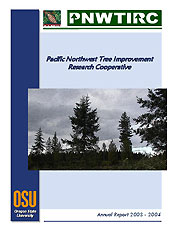Annual Report 2003-04
Highlights of 2003-2004
- Gancho Slavov completed his Ph.D. in June of 2004. His dissertation was entitled “Development and Application of SSR markers for Measuring Gene Flow in Douglas-fir.”
- PNWTIRC personnel published 12 journal articles and abstracts (i.e., published or submitted) and gave two other presentations that deal with PNWTIRC research projects.
- We used nine SSR markers to measure pollen contamination and characterize mating patterns based on seed samples collected in three years (1999, 2000, and 2003) from one block of a non-isolated, open-pollinated, clonal seed orchard of Douglas-fir (Pseudotsuga menziesii [Mirb.] Franco) in western Oregon. Pollen contamination was consistently high across the three years (mean = 35.3%, range = 31.0-41.3%), and appeared to result primarily from cross-pollination among the orchard blocks. Levels of pollen contamination varied substantially among clones, and were higher in clones with early female receptivity (mean = 55.5%) than in those with either mid (mean = 36.4%) or late (mean = 28.3%) female receptivity. There was a clear pattern of positive assortative mating with respect to floral phenology. This study illustrates that SSR markers are powerful tools for characterizing seedlots and improving the design and management of Douglas-fir seed orchards.
- We completed the early flowering study. Results from this study indicate that cone and seed production can be enhanced by stimulating very young grafts with a combination of girdling and gibberellic acid (GA). During the past year, we investigated the effects of our flower stimulating treatments on tree growth, cone abortion, number of seeds per cone, and seed weight. These analyses indicate that the flower stimulating treatments have no major adverse effects on tree health or seed traits, although GA concentrations higher than the recommended rates may have some detrimental effects on very young grafts. We treated some of the trees with insecticides and estimated seed yields at age 6. Using our recommended treatment every other year, it should be possible to obtain 4.5 kg of seed/hectare per year in the orchard we studied (i.e., 8 x 13 foot spacing). Extrapolating our results to a micro-orchard situation (i.e., 1 x 3 m; 3.3 x 9.8 foot spacing), it might be possible to harvest as much as 14.4 kg filled seed/ha per year at age 6 (i.e., 28.8 kg/ha every other year).
- We held a technology transfer workshop entitled “Genetics and Growth Modeling Workshop” on November 4-6, 2003. This workshop was organized in collaboration with the USFS Pacific Northwest Research Station, Northwest Tree Improvement Cooperative, Stand Management Cooperative, Port Blakely Tree Farms, and the Department of Forest Science at Oregon State University.


